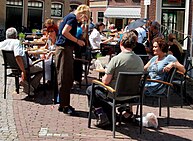Bounded rationality
Therefore, humans do not undertake a full cost-benefit analysis to determine the optimal decision, but rather, choose an option that fulfills their adequacy criteria.
Many economics models assume that agents are on average rational, and can in large quantities be approximated to act according to their preferences in order to maximise utility.
In another work, he states "boundedly rational agents experience limits in formulating and solving complex problems and in processing (receiving, storing, retrieving, transmitting) information".
[4] Simon describes a number of dimensions along which classical models of rationality can be made somewhat more realistic, while remaining within the vein of fairly rigorous formalization.
These include: Simon suggests that economic agents use heuristics to make decisions rather than a strict rigid rule of optimization.
[10] Thus, in order to test the mental limits of agents, complex problems, such as those within chess, should be studied to test how individuals work around their cognitive limits, and what behaviours or heuristics are used to form solutions[11] Anchoring and adjustment are types of heuristics that give some explanation to bounded rationality and why decision makers do not make rational decisions.
The availability heuristic refers to how people tend to overestimate the likelihood of events that are easily brought to mind, such as vivid or recent experiences.
[14] These mental shortcuts and systematic errors in thinking demonstrate how people's decision-making abilities are limited and often deviate from perfect rationality.
An example of bounded rationality in individuals would be a customer who made a suboptimal decision to order some food at the restaurant because they felt rushed by the waiter who was waiting beside the table.
[22] On the other hand, another extension came from the notion of bounded rationality and was explained by Ulrich Hoffrage and Torsten Reimer in their studies of a "fast and frugal heuristic approach".
Additionally, personal values, the way in which alternatives are discovered and created, and the environment surrounding the decision-making process are also not considered when using this theory.
The concept was popularized by Richard Thaler and Cass Sunstein in their 2008 book "Nudge: Improving Decisions About Health, Wealth, and Happiness.
One way nudges are used is with the aim of simplifying complex decisions by presenting information in a clear and easily understandable format, reducing the cognitive burden on individuals.
[32] Nudges can also guide people towards satisfactory options when they are unable or unwilling to invest the time and effort to find the optimal choice.
For example, providing a limited set of well-designed investment options in a retirement plan can help people make better financial decisions.
[33][34][35] Other dynamic models interpret bounded rationality as “looking for the direction of improvement“[36] such that agents use a gradient climbing approach to increase their utility.
[39] Bounded willpower refers to the idea that people often have difficulty following through on their long-term plans and intentions due to limited self-control and the tendency to prioritize short-term desires.
The concept of bounded willpower is closely related to the idea of hyperbolic discounting, which describes how people tend to value immediate rewards more highly than future ones, leading to inconsistent preferences over time.
[39] However, people's concern for others is often bounded in the sense that it is limited in scope and can be influenced by factors such as in-group favoritism and emotional distance.
The collaborative works of Daniel Kahneman and Amos Tversky expand upon Herbert A. Simon's ideas in the attempt to create a map of bounded rationality.
[41] Three major topics covered by the works of Daniel Kahneman and Amos Tversky include heuristics of judgement, risky choice, and framing effect, which were a culmination of research that fit under what was defined by Herbert A. Simon as the psychology of bounded rationality.
[42] In contrast to the work of Simon; Kahneman and Tversky aimed to focus on the effects bounded rationality had on simple tasks which therefore placed more emphasis on errors in cognitive mechanisms irrespective of the situation.
In particular, Kasthurirathna and Piraveenan[45] have shown that in socio-ecological systems, the drive towards improved rationality on average might be an evolutionary reason for the emergence of scale-free properties.
